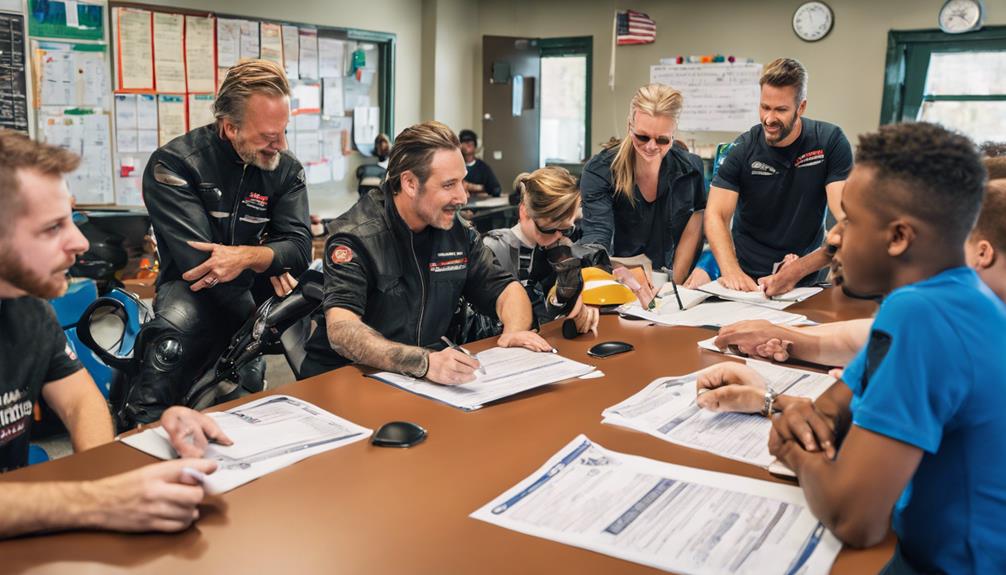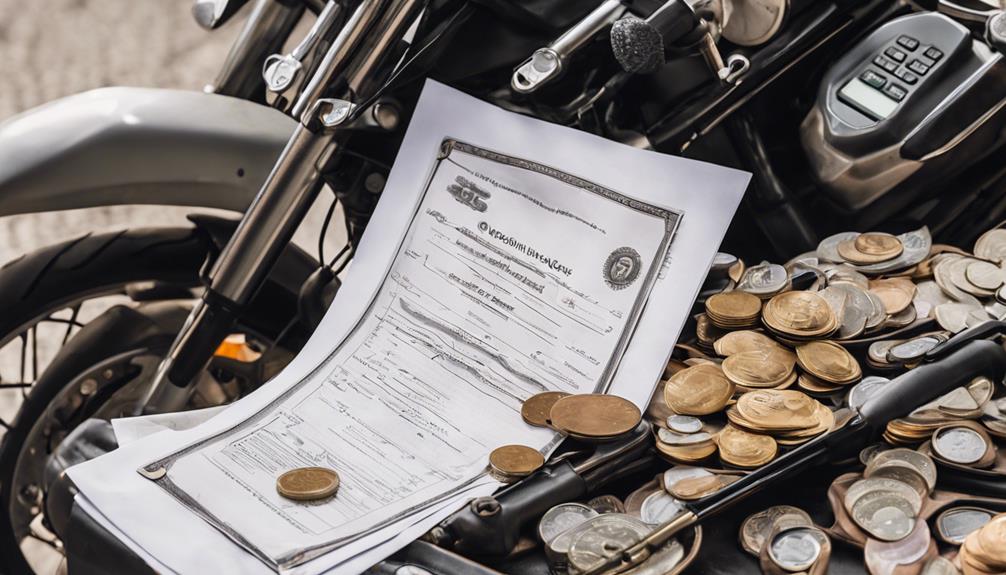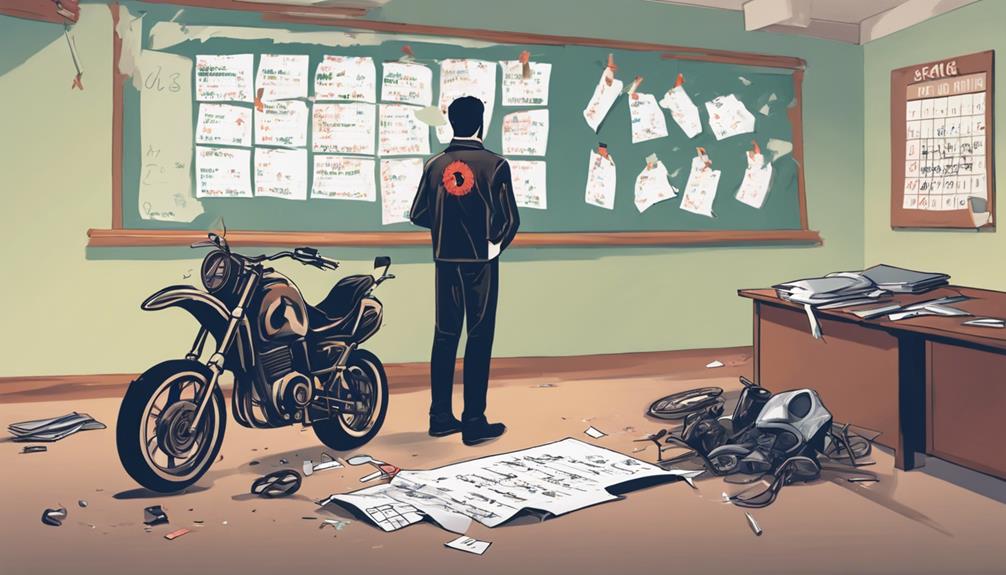When you consider opening a motorcycle school in Wisconsin, understanding the $20,000 bond requirement is essential. This bond not only acts as a financial safety net but also reflects your commitment to maintaining high standards and protecting your students. You might wonder what steps are involved in obtaining this bond and how it impacts your operation. As you navigate through the requirements and implications, it becomes clear that this bond is more than just a formality—it's a key element in building trust and credibility in your business. What else should you know before moving forward?
Overview of the Bond Requirement

When starting a motorcycle school, you need to understand the bond requirement that ensures financial responsibility. This bond acts as a guarantee that you'll adhere to the regulations and maintain a certain level of professionalism in your operations, as it plays a crucial role in ensuring compliance with laws and regulations for licensed businesses.
It's crucial for protecting your students, the public, and your business. Specifically, the bond typically requires you to secure a set amount—often $20,000, depending on your state's regulations. This amount serves as a financial safety net, assuring that funds are available should any claims arise due to negligent practices or non-compliance. By obtaining the bond, you demonstrate your commitment to operating ethically and responsibly.
Moreover, the process of securing this bond involves working with a surety company, which assesses your financial stability and background. They'll evaluate your credit history, business practices, and overall risk before issuing the bond.
Understanding this process is vital, as it can affect both your startup timeline and costs. For more details on how bonds protect the public, see License and Permit Bonds.
Importance of the ,000 Bond
The $20,000 bond holds significant importance for your motorcycle school, acting as a crucial safety net for both your students and your business. This bond ensures that you're financially responsible, providing peace of mind to your students and their families. It shows that you're committed to maintaining high standards and protecting individuals against potential mishaps.
Additionally, having a performance bond not only enhances your credibility but also affirms your dedication to fulfilling project obligations and safeguarding your clients' interests, as outlined in the Performance Bond Overview.
When you have this bond, it demonstrates your professionalism and integrity, attracting more students who seek reliable training. If any issues arise, such as unfulfilled contracts or negligent practices, the bond acts as a financial guarantee that students can seek compensation from. This helps maintain trust in your school and fosters a positive reputation in the community.
Furthermore, having the bond can prevent legal issues that might arise from claims against your school. By protecting yourself and your students, you create a safer learning environment that encourages growth and confidence.
Ultimately, the $20,000 bond isn't just a requirement; it's a vital investment in the success and sustainability of your motorcycle school. It reassures everyone involved that you take your responsibilities seriously and are prepared to uphold your commitments.
Who Needs the Bond?

Identifying who needs the $20,000 bond is essential for ensuring compliance and trust in your motorcycle school. If you're planning to operate a motorcycle training program in Wisconsin, you'll likely need this bond. It's designed to protect students and the public from any potential misconduct or financial losses related to your operations.
Furthermore, securing the bond helps ensure compliance with various state regulations, similar to how Louisiana surety bonds protect local governments and facilitate safe operations.
As an owner or operator of a motorcycle school, you're the primary party needing the bond. This requirement applies whether you're starting a new school or already running one.
In addition, instructors who provide training at your school may also need to be covered under this bond, ensuring that they meet the necessary standards and regulations.
Furthermore, if you're involved in any partnerships or franchises, each entity may require its own bond. This helps to maintain accountability across the board.
Steps to Obtain the Bond
Obtaining the $20,000 bond for your motorcycle school is often a straightforward process.
First, you'll need to gather essential documents, such as your business license, financial statements, and any required permits. This information helps the surety company assess your eligibility for the bond.
Next, research and choose a reputable surety bond provider. You can find several companies online or through local insurance agents. Reach out to them to get quotes and compare their terms.
Once you've selected a provider, complete their application. Be prepared to provide the gathered documents along with personal and business information.
After submitting your application, the surety company will review your information and conduct a credit check. This step helps them determine your risk level.
If approved, you'll receive a bond quote. Review the terms carefully, and if you agree, sign the bond agreement.
Costs Associated With the Bond

Understanding the costs associated with your motorcycle school bond is crucial for budgeting effectively. The primary expense you'll face is the bond premium, which is typically a percentage of the total bond amount.
For a $20,000 bond, this premium usually ranges from 1% to 10%, depending on your credit score, business history, and financial stability. If your credit is strong, you can expect to pay on the lower end of that scale.
In addition to the premium, you might encounter administrative fees charged by the bonding agency. These fees can vary, so it's essential to ask for a complete breakdown of costs upfront.
Also, consider any potential costs for required paperwork or documentation, as these can add to your overall expenses.
Bond Renewal Process
As your motorcycle school bond approaches its expiration date, it's important to start the renewal process to maintain compliance and avoid any interruptions in your business operations.
Begin by reviewing your bond's terms and conditions to understand the renewal timeline. Typically, you'll want to initiate the process 30 to 60 days before the expiration date.
Next, contact your surety provider to discuss the renewal requirements. They may require updated financial information or documentation to assess your risk level again.
Prepare any necessary paperwork, and be ready to answer questions regarding your business operations and financial standing.
Once you've gathered the required documents, submit them to your surety company. They'll evaluate your application and may provide a new premium quote based on any changes in your financial situation or market conditions.
If you agree to the new terms, pay the renewal premium promptly to reactivate your bond.
Ensure you receive confirmation of the renewed bond, as this will serve as proof of your compliance.
Keeping up with the renewal process not only safeguards your business but also builds trust with your students and regulators.
Consequences of Non-Compliance

Neglecting to renew your motorcycle school bond can lead to serious repercussions for your business. First, you may face fines or penalties from state authorities. These fees can accumulate quickly, impacting your bottom line.
Moreover, if you operate without a valid bond, you risk losing your license to teach motorcycle safety courses, which is your primary source of income.
Additionally, failure to comply with bonding requirements can damage your reputation in the community. Students may hesitate to enroll in your classes if they perceive your school as unreliable or untrustworthy. This can result in decreased enrollment numbers, further straining your finances.
You also expose yourself to potential lawsuits. If a student suffers an injury during training while you're out of compliance, you could be held liable without the protection a bond provides. This could lead to costly legal battles that threaten your financial stability.
Tips for Motorcycle School Owners
Running a successful motorcycle school requires not just passion for riding but also savvy management skills. First, ensure you have the right certifications and insurance in place. This protects both you and your students.
Next, invest in quality training materials and equipment. Having well-maintained bikes and safety gear not only enhances the learning experience but also builds your school's reputation.
Marketing your school effectively is crucial. Utilize social media, local events, and partnerships with motorcycle shops to attract students. Offer promotions or referral discounts to encourage word-of-mouth marketing.
Foster a positive learning environment by hiring skilled instructors who share your values. They should be not only knowledgeable but also patient and engaging. Regularly assess their performance and provide ongoing training.
Create a structured curriculum that covers essential skills and safety practices. This keeps your classes organized and ensures students gain the necessary knowledge.
Conclusion
In summary, the $20,000 bond requirement is essential for motorcycle schools in Wisconsin, ensuring compliance and student protection. By securing this bond, you not only enhance your school's credibility but also create a safer learning environment. Remember to follow the necessary steps to obtain and renew your bond on time. Staying compliant not only protects your business but also builds trust with your students, ultimately contributing to your school's success in the competitive motorcycle training industry.


